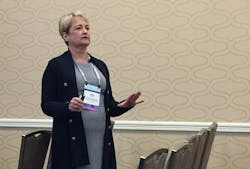Air Liquide’s Internal Digital Revolution
There’s a great deal of focus across industry on using Industrial Internet of Things (IIoT) technologies and artificial intelligence (AI) to implement predictive maintenance. The question for most companies is how to go about doing so in an effective way. Air Liquide saw AVEVA’s PRiSM software as a proven, off-the-shelf product through which to leverage the IIoT and AI for predictive maintenance operations.
Air Liquide provides gases such as oxygen, nitrogen, argon and hydrogen to a range of industries. Although it’s a very large company, Air Liquide operates with lots of smaller plants all over the world—a concept called Many Mini that enables it to be closer to its customers.
With this sort of setup, Air Liquide cannot afford to have all the necessary subject matter experts at each plant—even a large plant might have only 10 people total. So subject matter experts are generally located centrally, noted Ann Attaway, SIO.Predict program manager for large industries worldwide industrial management at Air Liquide. “Being able to capitalize on this digital transformation has been wonderful for us,” she said. “It lets us get the right people in the right location at the right time.”
Smart Innovative Operations (SIO) is Air Liquide’s own internal digital revolution, Attaway said, identifying the program’s SIO.Predict, SIO.Perform, SIO.Drive and SIO.Optim components. Air Liquide had “two libraries of congresses full of SCADA data that people weren’t really doing anything with,” she noted. “Now we can capitalize on that data all the time. We can better serve our customers, improve our offer, and provide value creation for our customers and for us.”
SIO.Predict, focused on predictive analytics, gets benefits from PRiSM that include improving operational reliability and availability, getting a second set of eyes on operations, and right-sizing maintenance activities.
Prior to using PRiSM, Air Liquide kept its SCADA system happy by keeping operations within a fairly large rectangle of parameter limits. But by using the historical data available, their AVEVA solution could bring those operations into a much tighter optimal box. PRiSM calculates the overall model residual (OMR), which is the difference between where you’re operating today and the optimal blue box. Every five minutes or so, PRiSM calculates the OMR to keep those conditions closer to optimal. “This has worked really well for Air Liquide,” Attaway said, noting the improved ability to predict when an asset will fail. “In some cases, we’re getting six to eight months of warning.”
This also provided a second set of eyes on operations—particularly important for sites that are unmanned on nights or weekends, Attaway said. “It can tell us if it’s ‘normal’ compared to our history,” she added. In one example of this, the predictive analytics spotted what turned out to be a bad weld on a system. When the welder came out to make fixes, he realized that there was a lot of bad welding throughout that section of the plant, so could catch mistakes that might have been a significant cost to the company in repairs and downtime.
Right-sizing maintenance activities can also provide a big monetary return, Attaway said. A project in the Middle East had to be done during a turnaround that was at first supposed to be four weeks, but then got changed to just two weeks. “We had to figure out what we were not going to do,” she said. AVEVA helped with this by graphing three-hour periods of data. “This is how you’re able to go from time-based maintenance to actual predictive maintenance based on asset health. In this case, we saved ourselves two weeks of turnaround time.”
Attaway has several pieces of advice for companies considering implementing a predictive analytics program:
- Get the right sponsor. This should be a respected, influential executive who has the control to be able to coordinate between various groups.
- Get the right people involved. They should also be respected and influential. “They’re not necessarily your best subject experts, but they’re your most influential subject experts,” Attaway said. Then give them free reign in their areas of expertise.
- See how other companies have done this. “We were able to visit two or three companies,” Attaway said, “and could ask specific questions that helped us with our planning.”
- Fail early and react honestly. Air Liquide failed early on by getting too many false alarms, Attaway noted. “But we changed the template, and nobody resented that. We ended up gaining credibility instead of losing it.”
- Track impact. Though every company Air Liquide spoke with stressed the importance of tracking the decreased cost of unreliability with every catch, they weren’t very concerned about that. “But they were right,” Attaway said, noting the web page they now have listing those costs. “My boss and his boss and his boss’s boss are constantly checking that page.” This, in turn, makes it easier to get more money for projects.
- Get the right mix of requirements and creativity. Managers must use Attaway’s templates, but then they are free to do whatever else they want. In many cases, this ultimately improves the original templates.
With predictive analytics, Air Liquide has made more than 275 catches to date. The gas supplier has deployed more than 3,000 models, monitoring more than 130 locations. It has established a worldwide network of predictive analytics. The cost of unreliability has been significantly reduced worldwide.
“The main thing I like about predictive analytics is that it lets us have new partnerships between customers, operations, analysts and subject matter experts,” Attaway said. “We discuss and decide instead of just react and repair.”

